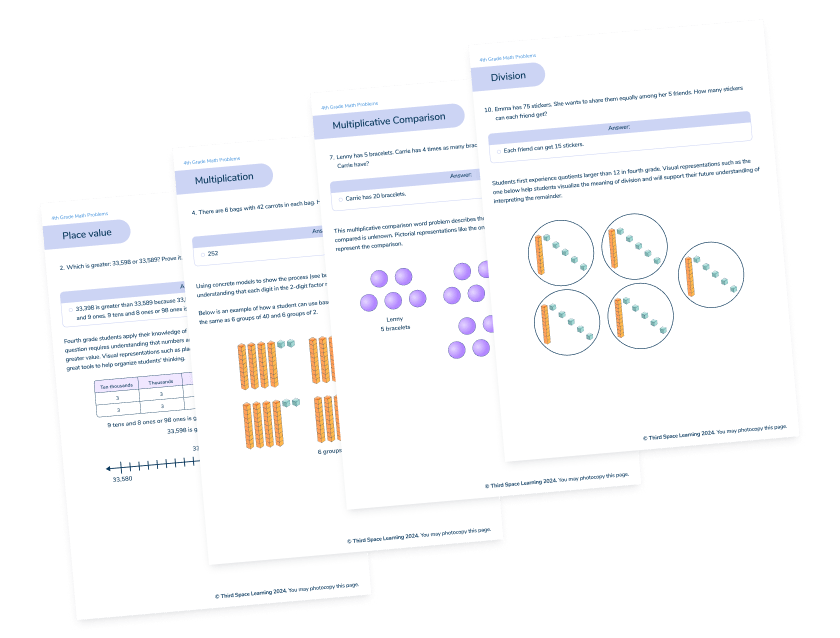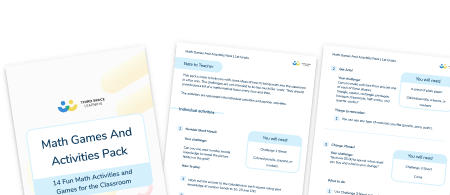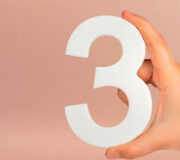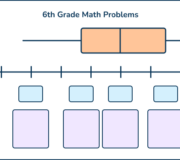36 Math Problems For 1st Graders With Answers & Teaching Ideas
Math problems for 1st graders connect kindergarten math skills to 2nd grade math skills and beyond. 1st grade math problems focus on building an understanding of addition and subtraction and learning a variety of strategies for efficient problem-solving.
This blog post covers the key areas for 1st grade math problems including addition and subtraction, place value, measurement, fractions, telling time, representing data and shapes. It includes ready-to-use math problems with solutions and strategies for teaching 1st grade math.
What are math problems for 1st graders?
Math problems for 1st graders are math problems for 6-7-year-olds. These first grade math problems are specific to 1st grade math skills and are designed for 1st grade students.
They build on kindergarten math concepts such as counting and simple addition by transitioning to more complex problems such as addition and subtraction up to 20.
1st grade math problems also set the foundation for 2nd grade math and beyond.
14 Fun Math Games and Activities Pack for 1st Grade
14 fun math games and activities for 1st grade students to complete independently or with a partner. All activities are ready to go and suitable to a range of abilities.
Download Free Now!Math curriculum for 1st graders
1st grade math problems cover a range of skills across four domains of Common Core Math Standards including:
- Operations and Algebraic Thinking
- Numbers and Operations in Base Ten
- Measurement and Data
- Geometry
By first grade, students are expected to connect counting and cardinality skills to addition and subtraction and be fluent in their addition and subtraction facts within 5.
The first grade math year is important in the K-5 math progression; it introduces addition and subtraction with numbers up to 20 and addition with numbers up to 100. It also covers the idea of decomposing a number into tens and ones (by place value), a necessary skill for 2nd grade, 3rd grade, 4th grade and 5th grade math.
This foundational year focuses on hands-on math manipulatives and visual models to build the conceptual understanding needed for more advanced math in later years.
In first grade, students learn new skills such as:
- Simple addition and subtraction (with numbers up to 20)
- Addition and subtraction word problems
- Place value with 2-digit numbers
- Addition within 100 (adding a 2-digit number and a 1-digit number and/or a 2-digit number and multiples of ten)
- Sequences and missing numbers
- Basic fraction concepts and partitioning shapes
- Telling time (analog and digital)
- Measurement (measuring and comparing objects using basic measurement units)
- Representing data
- Shapes
First graders are expected to be fluent in addition and subtraction math facts within 10 by the end of the grade. These addition and subtraction skills are integrated into the other math content throughout 1st grade to solidify skills and apply them to real world math situations.
All 1st grade math skills set the foundation for second grade and third grade skills such as adding and subtracting larger numbers, multiplication and division concepts and more.
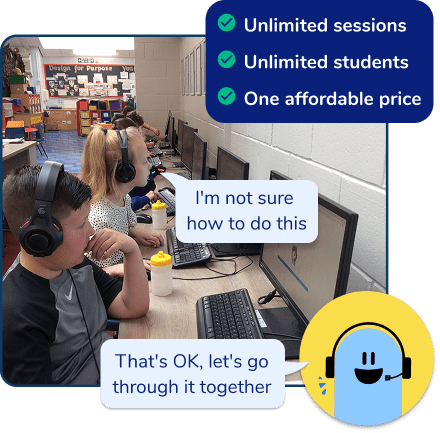
Meet Skye, the voice-based AI tutor making math success possible for every student.
Built by teachers and math experts, Skye uses the same pedagogy, curriculum and lesson structure as our traditional tutoring.
But, with more flexibility and a low cost, schools can scale online math tutoring to support every student who needs it.
Find out more36 math problems for 1st graders and answers
The following is a collection of 1st grade math problems, organized by domain and skill.
Each problem includes an answer key and explanation of how to answer the math question.
Math problems for 1st graders: Operations & Algebraic thinking
Operations & Algebraic thinking focus on addition and subtraction skills within 20. At the first grade level, students learn efficient strategies for adding and subtracting and develop fluency with addition and subtraction within 10.
First graders also use the properties of operations to add and subtract, relate addition to subtraction and develop an understanding of the meaning of the equal sign.
Simple addition and subtraction within 20
Question 1
5 + 7 = ___
Answer: 12
There are a variety of strategies students can use to solve this problem. They can count on/add on 7 from 5. But, to solve the problem more efficiently they can use the commutative property to switch the order of the addends so the larger addend is first.
The problem becomes 7 + 5 which means they can more easily count on 5 from 7. Students can use a visual model such as counters in a double ten frame to support their thinking.
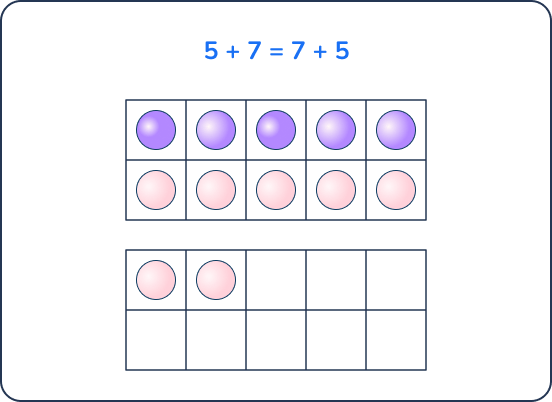
Question 2
7 + 6 = ___
Answer: 13
This problem has the larger addend first. An efficient way to add is to break apart the second addend.
Using this strategy allows students to focus on ways to make ten. For example, 6 can decompose into 3 + 3. Then students can add in parts:
- 7 + 3 = 10
- 10 + 3 = 13
Anchoring to 10 is an efficient strategy that bridges larger problems and allows students to use their knowledge to solve larger problems.
Teachers can support student understanding by encouraging them to use a double 10 frame.
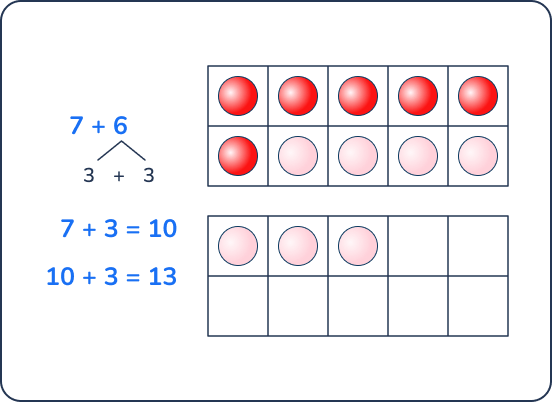
Question 3
8 + ___ = 15
Answer: 7
This problem is framed as a missing addend problem, which connects addition strategies to subtraction.
To find the missing value, students would subtract 15 – 8. However, students can use an addition strategy to support their subtraction problem solving. Students could add on from 8 to 15, adding in parts by anchoring to a 10.
Using a number line is a helpful strategy to find the difference between 8 and 15. Students can find the difference by adding on or subtracting back.

Question 4
9 – 5 = ___
Answer: 4
Students can solve this problem by subtracting 5 from 9. They can model this on a number line or a ten frame.
Knowing fact families within 10 will help students solve this problem more efficiently. If a student knows that 5 + 4 = 9, they know that 9 – 5 = 4 and 9 – 4 = 5.

Question 5
14 – 8 = ___
Answer: 6
This problem appears more difficult than the previous subtraction problem because the minuend (first number in the equation) is a two-digit number.
If solving this problem using the standard algorithm/’place value’ subtraction, regroup/rename 4 ones for 14 ones.
However, in first grade, students do not use the standard algorithm for subtraction. First grade math focuses on building conceptual understanding and efficient mental math strategies.
Teachers should emphasize that anchoring to ten is a helpful strategy. First graders should learn to decompose the 8 into 4 + 4. Then they can subtract on a number line or double ten frame:
- 14 – 4 = 10
- 10 – 4 = 6

Addition word problems
Question 6
There were 7 carrot plants and 4 tomato plants growing in the garden. How many total plants were growing in the garden?
Answer: 11 plants
First graders will become familiar with the structure of word problems like this. It is a simple part-part-whole problem.
Drawing a picture of the plants or a bar model helps children see the parts of the problem and the whole.
Using a double ten frame helps students anchor making a 10 to help them solve this problem. Students should label their work as they solve problems to make sense of the problem.

Question 7
9 friends were playing on the playground. 5 more friends joined. How many friends were playing on the playground all together?
Answer: 14 friends
This ‘join result unknown’ problem is great for visualizing the meaning of addition. Students can draw or act out 9 people and 5 more people joining. They can use counters or act it out with their peers.
A number line to anchor to 10 is a helpful visual model for solving this problem.

Question 9
Jesse has 5 stickers in his collection. Ben has 6 more stickers than Jesse in his collection. How many stickers does Ben have in his collection?
Answer: 11 stickers
Drawing a bar model helps students understand this comparison problem. This problem is a ‘doubles plus one’ problem.
Students can use the basic fact of 5 + 5 = 10, to see that this is 5 + 5 + 1. They can also anchor to 10 and break apart 6 into 5 + 1 to solve the problem.

Question 10
There are 3 more students with brown hair in Mr. Archer’s class than students with blonde hair. If there are 5 students with blonde hair in Mr. Archer’s class, how many students in class have brown hair?
Answer: 8 students have brown hair
A bar model/tape diagram is a visual model students will become familiar with as they begin problem solving with math word problem structures in 1st grade.
Bar models help students recognize that they need to add 5 + 3. They can add on 3 from 5 to get to 8.
By the end of the year, students should be fluent in math facts within 10 so they should know that 5 + 3 = 8 using mental math or with little think time.

Subtraction word problems
Question 11
There were 9 blueberries on my plate. I ate 3 blueberries. How many blueberries are left on my plate?
Answer: 6 blueberries
Drawing a traditional subtraction picture where students draw 9 circles for blueberries and then cross off 3 is a great problem solving strategy for basic separate result unknown problems.
Additionally, using counters and physically moving them helps students build a conceptual understanding of subtraction.

Question 12
Some birds were in an oak tree. 2 more birds joined. Now there are 10 birds in the oak tree. How many birds started in the oak tree?
Answer: 8 birds
This ‘join, start unknown’ problem is particularly challenging for first graders because they do not know the starting number.
Drawing a picture or using hands-on math manipulatives can help students see that the problem they are trying to solve is ___+ 2 = 10.
Then they can use their fact fluency within 10 or add on from 2 to 10.

Question 13
14 dogs were playing at the dog park. 9 dogs had long tails and the rest had short tails. How many dogs at the dog park had short tails?
Answer: 5 dogs
Teachers should encourage students to use a bar model for this part-part-whole problem. Students can see that if there are 14 total dogs and 9 have long tails they would need to subtract 14 – 9 to find the number of dogs with short tails.
To solve, students can add on from 9 to 14 or subtract from 14 to 9 on a number line.

Question 14
Julie bought a pack of 16 thank you cards. After her party, she mailed 8 of the cards. How many thank you cards did Julie have left?
Answer: 8 cards
Students can look for a way to make 10:
- 8 + 2 = 10
- 10 + 6 more is 16
- All together the difference is 6 + 2 which is 8
Alternatively, they could subtract:
- 16 – 6 to get to 10
- Then subtract 2 more to get to 8
By the end of 1st grade, students will be familiar with their doubles facts and will recognize more quickly that 8 + 8 = 16.

Math problems for 1st graders: Numbers & Operations in Base Ten
The numbers and operations in base ten for first grade focus on two-digit numbers. First graders learn to decompose or break apart 2-digit numbers using place value. They understand the meaning of tens and ones in each number and learn to compare 2-digit numbers.
This domain also focuses on transitioning from single-digit addition to double-digit addition. Students learn to add 2-digit numbers to 1-digit numbers within 100 and add and subtract multiples of 10 from 2-digit numbers.
Students also use base ten blocks for actual problem solving, as opposed to kindergarten where blocks are used for modelling numbers. It is an important year for developing conceptual understanding of place value.
Place value
Question 15
Compare the following two numbers using the greater than, less than or equal to symbols (>, <, =).
35 ___52
Answer: 35 < 52
Students can build both numbers using base ten blocks or a quick picture to see that 52 has 5 tens and 35 only has 3 tens so 52 is greater than 35.
A common misconception is that because there is a larger number in the one’s place then the number itself is larger, so students might think that 35 is greater than 52. Teachers must teach 1st graders to compare starting with the largest place value.

Question 16
Which number has a greater value: 48 or 84? Explain.
Answer: 84 has the greater value because 8 tens is more than 4 tens.
In first grade, students should always build and model numbers when comparing them by place value. This builds the foundation of conceptual understanding when they begin problem solving with larger numbers.
Using the vocabulary of ‘greater value’ is key.

Question 17
How many tens are in the number 73? Draw a picture to show your thinking.
Answer: 7 tens
Using base ten blocks helps children organize their thinking when decomposing numbers by place value.
Students can also use a place value chart to organize their work. Place value charts are increasingly important in the later grades so this is a good time to introduce that tool.

Question 18
There were 28 red cars and 32 black cars parked in the lot. Were there more red cars or black cars parked in the lot? How do you know?
Answer: There were more black cars because 28 < 32 (or 32 > 28)
Students could solve this problem by drawing pictures of cars but this is inefficient. Teachers can show students how it is much more efficient to use base ten blocks or a quick picture to model both numbers and compare the tens and ones.

Adding and subtracting using place value
Question 19
18 + 6 = ____
Answer: 24
To solve addition and subtraction problems within 100, first graders learn to use place value blocks for problem solving.
In this problem, they can model the number 18 with 1 ten and 8 ones and physically count on 6 more ones. They can replace 10 of the ones for one ten to see that they have the number 24.
Anchoring to smaller facts is helpful. If students know 8 + 6 = 14, it can help them solve 18 + 6.

Question 20
____ = 33 + 7
Answer: 40
In this problem, the unknown value is on the left side of the equal sign. This is intentional. In first grade, students learn that the equal sign means ‘the same value’ so one side should be the same value as the other side of the equal sign.
This is particularly challenging for students because they are used to the traditional format of a + b = c. Practicing balancing equations helps children understand this concept.
To solve, students can use their knowledge of making ten (3 + 7 = 10) to add 33 + 7 to get to the next multiple of ten which is 40.
A number line is a helpful strategy for visualizing this problem.

Question 21
40 – 10 = ____
Answer: 30
Using a hundreds chart is beneficial for first graders to subtract multiples of ten. It allows students to see how when adding or subtracting ten from a number, the digit in the one’s place remains the same but the digit in the tens place changes.

Question 22
____ = 62 + 10
Answer: 72
By the end of first grade, students should be able to add ten to a given two-digit number using mental math.
However, for fluency, a hundreds chart or base ten blocks are a helpful visual for seeing these large numbers.

Sequencing and missing numbers
Question 23
Look at the sequence of numbers below. What is the next number in the sequence?
90, 80, 70, 60, 50, 40, ____
Answer: 30
Students can solve this problem using base ten blocks and taking one block away to model each step of the sequence.
They can also move a transparent counter across the hundreds chart to see that the next number is 30.
Missing number problems are challenging for students but teachers can help first graders understand these problems by showing them that by finding the difference between each number in the sequence, they can solve for the next number.

Question 24
Find the missing number in the sequence:
25, 35, 45, 55, ____, 75, 85
Answer: 65
Using the same strategies as the previous problem, students can find the difference between each number in the sequence. Once they see that the difference is ten, they can use a number line, base ten or hundreds chart to add 10 to 55 or subtract 10 from 75 to find the missing number.

Math problems for 1st graders: Measurement & Data
Students learn the basics of linear measurement in first grade. They learn to use other objects as units and basic measurement units to measure objects.
First graders do not use standard units of measure such as inches or centimeters for most measuring situations. Instead, they compare objects to determine the length. For example, they might measure the length of a desk using pencils as the unit to see how many pencils long the desk is. This prepares students for learning standard measurement units in 2nd grade.
1st graders learn the foundation of time reading a clock to the nearest half hour, and basic data organization, such as tally marks to record data.
Measurement
Question 25
Which of the following objects is about the same length as a new pencil?
- Bicycle
- Desk
- Fingernail
- TV Remote
Answer: D TV Remote
Students need to use estimation skills to determine a reasonable answer. A TV remote may not be exactly the size of a pencil, but it is close to the length of a pencil. A bicycle and desk are much bigger and a fingernail is much smaller.
Estimating lengths is an important skill for first graders so they can use non-standard units to measure and compare objects. For example, determining how many pencils long a desk is, or how many pencils tall they are.
Question 26
Put the following people in order from tallest to shortest:
Quinn: 3 desks tall
Ivy: 2 desks tall
Jordan: 4 desks tall
Answer: Jordan, Quinn, Ivy
Emphasize that the desks are all the same size, so the unit is the same for each person and that all measurement units should be used with no gaps or overlaps.
Question 27
Use a standard piece of paper as a measurement unit. How many pieces of paper long is your desk?
Answer: Answers will vary based on desk and paper size.
First graders must get practice with hands-on measuring. Students must be able to use tools to measure lengths.
In this case, the piece of paper is the measurement unit. Teachers should instruct students to check their answers to ensure they are reasonable.
Telling time
Question 28
I have a dentist appointment at 5:00. Which clock below shows 5:00?
Answer: A
In first grade, students are introduced to reading digital and analog clocks. They must learn the meaning of the minute hand and the hour hand.
For this problem, students need to identify that the hour hand should point to 5 and the minute hand should point to 12 because it is the beginning of the hour.

Question 29
Choose the clock(s) that shows 6:30. What is something that you might do at 6:30? How does that differ from 6:30 in the morning and 6:30 at night?
Answer: B & C
This time word problem helps teachers identify misconceptions about digital and analog clocks when teaching time. If a student chooses option D, they do not understand how time is represented on a digital clock.
6:30 is a challenging time to show on a clock so students must recognize that the hour hand is halfway past the 6 and the minute hand is pointing towards the 6.

Question 30
Match the three digital clock times to the corresponding time on the analog clocks.

Answer:

Organizing data
Question 31
The students in Mr. Jensen’s class voted for their favorite color. The data was collected in the chart shown below. How many more students voted for blue than voted for green?
Answer: 3 more students
Tally marks are more organized than drawing dots or making unorganized lines because students can go back and more easily see the numbers because of the bundles of 5.
For example, for blue, they can see a group of 5 and 2 more. If they compare that to the 4 tally marks for green, they know they just have to find the difference between 7 and 4 to find the answer.

Question 32
Oliver kept track of the number of bicycles and tricycles he saw ride past his house on Tuesday. He used tally marks to organize his data. How many total bicycles and tricycles did Oliver see ride past his house on Tuesday?
Answer:
1st graders learn the basics of data organization, including:
- Title
- Labels
- Structure (in this case, a t-chart)
This sets the foundation of organization for more advanced data representation models such as bar graphs and line plots in later years.
Students must read and understand all the parts of a graph or chart and interpret the data.

Math problems for 1st graders: Geometry
First grade geometry teaches students the defining attributes of shapes such as the number of sides and angles and non-defining attributes such as color and size.
1st graders also learn the basics of how to:
- Compose two-dimensional and three-dimensional
- Partition circles and rectangles into equal shares, setting the foundation for fractions
Shapes
Question 33
Which of the shapes below is not a rectangle? How do you know?
Answer: D
For this problem, students should identify that the defining attributes of a rectangle are that it has 4 sides and 4 angles and that the angles are all the same size, or right angles. D has 5 sides and 5 angles so it is not a rectangle.

Question 34
Two triangles were put together to make this shape. What is the name of the new shape?
Answer: Square
The two right triangles compose a square with sides the same length. Students might also answer rectangle if they are not sure that all sides are the same length. Students should see that together two three-sided shapes can create a four-sided shape.

Basic fractions
Question 35
If you wanted to share a pizza equally between two people, which pizza should you choose? Why?

Answer: B
To share a pizza equally partition the pizza into two equal-sized pieces. In A and C, the pizza is cut into two pieces but the pieces are equal.
In first grade, teachers should emphasize that partitioning shapes equally means making equal-sized shares.
Question 36
Partition the picture of a chocolate bar into fourths. How many people can share the chocolate bar equally?

Answer:

First graders should practice folding paper and partitioning hands-on models into equal shares, drawing these models on paper, and identifying models shared equally.
Attending to precision and ensuring all the parts are equal is an important step at this level. This helps students build a foundation of understanding that they can build on as they learn about fractions in later grades.
3 top tips for teaching 1st grade math problems
First grade is an important transition year for children to connect their counting and basic addition/subtraction skills from kindergarten to adding and subtracting with larger numbers.
Here are three tips for elementary math teaching to support 1st grade students build an understanding of new math concepts:
- Follow the CRA progression and transition from concrete, to representational, to abstract models.
- Use purposeful visual models such as ten frames, double ten frames and number lines to help children understand addition and subtraction.
- Build fluency with addition and subtraction math facts within 10 by anchoring to facts students know within 5. Similarly, encourage students to find ways to make ten to support them with solving larger problems within 20 and beyond.
1st grade math worksheets and resources
Looking for more resources? Check out our math games and our selection of first grade printable math worksheets, posters and digital activities covering 1st grade key math topics and more:
- 14 Fun Math Games And Activities Pack For 1st Grade
- Summer Math Activities For 1st and 2nd Grade
- 2D Shapes Math Posters Kindergarten – Grade 1
Frequently asked questions
What math should a 1st grader know?
By the end of 1st grade, students should: Add and subtract numbers up to 20 Be fluent in addition and subtraction math facts within 10 Understand the base ten number system and compare 2-digit numbers by place value Add 2-digit numbers to 1-digit numbers Subtract multiples of 10 from any 2-digit number Tell time to the nearest half-hour Organize data Measure and compare the lengths of various objects Identify defining attributes of shapes Partition shapes into two and four equal shares
What are the mathematical concepts for 1st grade?
1st graders learn math in 4 different domains or content areas. The main focus of these domains is: Addition and subtraction of numbers up to 20 with fluency in adding and subtracting to 10 Place value up to 2-digit numbers 1-digit addition and basic 2-digit addition Telling time Basic measurement concepts Early fraction concepts Organizing data and geometry
What are good questions to ask a 1st grader?
First grade is a pivotal year for students to make connections between adding and subtracting smaller numbers and larger numbers. Students should develop their identity as mathematicians, focusing on a growth mindset. Ask questions such as: What makes you feel confident in math? Is there an area of math you need more support in? Explain. Which hands-on tools do you like to use for solving math problems? Which picture or visual model could help you solve that problem? When solving, for example, the problem 7 + 8, you might say, ‘Do you see a way to make 10 in this problem?’ When solving a problem such as 27 + 8, you might say ‘Can you use 7 + 8 to help you solve this problem?’ Try solving this problem in two different ways. Which strategy was most efficient for this problem?
Do you have students who need extra support in math?
Skye—our AI math tutor built by experienced teachers—provides students with personalized one-on-one, spoken instruction that helps them master concepts, close skill gaps, and gain confidence.
Since 2013, we’ve delivered over 2 million hours of math lessons to more than 170,000 students, guiding them toward higher math achievement.
Discover how our AI math tutoring can boost student success, or see how our math programs can support your school’s goals:
– 3rd grade tutoring
– 4th grade tutoring
– 5th grade tutoring
– 6th grade tutoring
– 7th grade tutoring
– 8th grade tutoring
